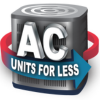As the HVAC industry evolves, Daikin, Goodman, and Amana have announced plans to replace R-410A with R-32 in their comfort cooling products. This transition aligns with a broader movement towards refrigerants with a lower Global Warming Potential (GWP), driven by regulations like California's proposed GWP limit of 750 for new air conditioning systems starting January 1, 2023.
Why R-32?
R-32, a mildly flammable A2L refrigerant, offers a promising alternative with a lower GWP. It's already in use globally, with over 100 million units in operation. Daikin, Goodman, and Amana's endorsement of R-32 marks a significant shift in their product lines, including both ducted and ductless residential and commercial systems.
Performance Benefits
Philip Johnston from Daikin Applied explains that R-32 has superior thermodynamic capacity and efficiency compared to R-410A and other A2L refrigerants like R-454B. Tests show that R-32 can improve the Integrated Energy Efficiency Ratio (IEER) by 8% over R-410A. This translates to reduced power consumption, lower operating costs, and a smaller carbon footprint. Although R-32 operates at slightly higher pressures and temperatures, these factors have been addressed by compressor manufacturers, ensuring reliability and performance.
System Similarities and Differences
Nathan Walker from Goodman Manufacturing highlights that R-32 systems will appear similar to R-410A units, with minor differences in components like compressors and expansion valves to optimize R-32's properties. Most existing refrigerant lines can be reused with R-32 systems, though a thorough flush is recommended to remove residual oils and refrigerants.
Charging and Installation
R-32 systems typically require a 20-25% lower refrigerant charge than R-410A systems. Charging procedures remain similar, but technicians should be trained in handling A2L refrigerants, focusing on safety and proper tools. The installation process mirrors that of current systems, with added attention to safety precautions due to R-32's mild flammability.
Tools and Equipment
Most tools used for R-410A systems are compatible with R-32, but leak detectors must be A2L-compliant, and recovery equipment should be approved for use with mildly flammable refrigerants. Technicians should adhere to best practices and guidelines during installation and maintenance.
Storage and Transportation
Current storage and transportation guidelines for A2L refrigerants apply to R-32, with specific limits based on building codes and safety standards. Technicians should remain informed about regulatory updates as they emerge.
Addressing Concerns
Technicians may be apprehensive about using mildly flammable refrigerants. Walker reassures them by drawing parallels to past transitions, like from R-22 to R-410A, which were successfully managed despite initial concerns. Johnston emphasizes that R-32 presents an opportunity for improved efficiency and environmental benefits, aligning with global sustainability efforts.
Embracing R-32 can lead to significant advancements in HVAC systems, providing better performance and a reduced environmental impact. As the industry adapts, technicians will play a crucial role in ensuring a smooth transition to this new standard.


